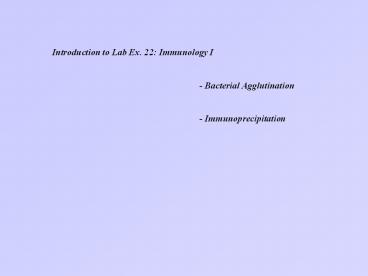Introduction to Lab Ex. 22: Immunology I - PowerPoint PPT Presentation
Title:
Introduction to Lab Ex. 22: Immunology I
Description:
Introduction to Lab Ex. 22: Immunology I - Bacterial Agglutination - Immunoprecipitation Introduction to Lab Ex. 22: Immunology I Bacterial Agglutination ... – PowerPoint PPT presentation
Number of Views:130
Avg rating:3.0/5.0
Title: Introduction to Lab Ex. 22: Immunology I
1
Introduction to Lab Ex. 22 Immunology I -
Bacterial Agglutination -
Immunoprecipitation
2
Introduction to Lab Ex. 22 Immunology I
Bacterial Agglutination -
Immunoprecipitation Immune responses include all
the activities of the immune system toward
maintaining the healthy status of the host.
These would include protecting against pathogens
foreign antigens Specific Immune responses are
one of two kinds Antibody-mediated
Cell-mediated Antibodies are proteins secreted
by specific immune cells to counteract and rid
the antigens (and thus the pathogens they may be
associated with) Antibodies are specific for the
antigen that trigger their formation. Depending
on the nature of the antigen the antigen-antibody
reactions result in different reactions, ex.
Agglutination or precipitation
3
BACTERIAL AGGLUTINATION . is the reaction
between a particulate antigen and its specific
antibodies
Antibody specificity known (S. enteriditis) Salmon
ella species identity not known
(?) Agglutination?reaction between antibody and
particulate antigen
?
agglutination
no agglutination
Table 1. Serological classification of some
common Salmonella species. Salmonella
species Serological group S. typhimurium B
S. paratyphi C C1 S.
enteriditis D S. anatum E
4
Bacterial agglutination
?
5
Bacterial agglutination
agglutination
no agglutination
?
6
Bacterial agglutination
Antibody specificity known (S. aureus)- antigen
on the surface of bacteria Staphylococcus
species identity not known (?)
?
agglutination
no agglutination
7
Bacterial agglutination
agglutination
no agglutination
?
8
Latex beads (dyed blue)
S. epidermidis
S. aureus
S. aureus-specific antibodies
9
Bacterial agglutination
Note these latex beads are dyed red
agglutination
no agglutination
?
10
Bacterial agglutination (new procedure).
1
Mark your bacterial agglutination cards
11
Bacterial agglutination
2
Mix the latex agglutination reagent dropper
bottle and dispense one drop onto each circle
12
Bacterial agglutination
3
Using a sterile toothpick , pick up and smear 1
suspect colony from your negative control in the
proper ring.
4
Using a NEW sterile toothpick , pick up and smear
1 suspect colony from your positive control in
the proper ring.
5
Using a NEW sterile toothpick , pick up and smear
1 suspect colony from your unknown in the proper
ring.
13
Bacterial agglutination (Part B).
6
Pick up and gently rock the card for 20 seconds
and observe for agglutination under normal
lighting conditions
?
14
- Immunoprecipitation
- - is the reaction between a soluble antigen and
its specific antibodies - soluble antigens are smaller and in solution
complexing with antibodies make these - bigger and they fall out of solution as a
precipitate visible to the eye.
Antibody specificity known (toxin, protein,
etc.) Antigen presence or identity not known
(?) Precipitation?reaction between antibody and
soluble antigen
15
Immunoprecipitation
Antibody specificity known (toxin, protein,
etc.) Antigen presence or identity not known
(?) Precipitation?reaction between antibody and
soluble antigen
16
Immunoprecipitation
17
Immunoprecipitation
Reaction of identity
Reaction of nonidentity































